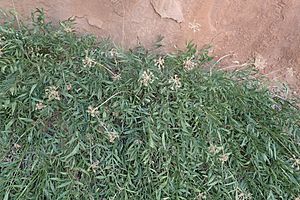Canyonlands lomatium facts for kids
Quick facts for kids Canyonlands lomatium |
|
|---|---|
 |
|
| Conservation status | |
| Scientific classification | |
| Kingdom: | |
| (unranked): | |
| (unranked): | |
| (unranked): | |
| Order: | |
| Family: | |
| Tribe: |
Selineae
|
| Genus: | |
| Species: |
L. latilobum
|
| Binomial name | |
| Lomatium latilobum (Rydb.) Mathias
|
|
Lomatium latilobum is a unique flowering plant. It belongs to the carrot family. People often call it Canyonlands lomatium or Canyonlands biscuitroot. This plant grows naturally in a specific area. This area is found along the border of Utah and Colorado in the United States. You can find some of these plants in famous places like Arches National Park and Colorado National Monument.
Contents
About the Canyonlands Biscuitroot
The Canyonlands biscuitroot is a perennial herb. This means it lives for more than two years. It grows from 10 to 30 centimeters tall. That's about the length of a ruler! The plant has a thick base called a caudex. This base is covered with old, dried leaves from past years.
What Does It Look Like?
The leaves of this plant are quite interesting. They are divided into several pairs of smaller leaflets. These leaflets can be shaped like a spear (lance-shaped) or an oval. Each leaflet can be up to 1.2 centimeters wide.
The plant's flowers are tiny and yellow. They grow in a cluster called an umbel. An umbel looks a bit like an umbrella. You can usually see these flowers blooming from April through June. One cool thing about this plant is its strong smell. It reminds many people of both lemon and licorice!
Where Does It Grow?
This special plant likes to grow in sandy cracks. You can find it in rocks like Navajo Sandstone and other types of sandstone. Its home is often in pinyon-juniper woodlands. It also lives in desert scrub areas. These are all types of plant communities where it thrives.
Why Is It Special?
Scientists believe there are only about 12 to 17 groups of these plants left. Some of these groups are based on old records. It's possible they might not even exist anymore.
Some of these plants are lucky. They are protected inside national parks and monuments. However, even in these protected areas, they face challenges. People who enjoy outdoor activities like hiking can accidentally disturb them. These plants are very sensitive. They can be easily pulled out of the ground if someone steps on them. This makes it important to be careful when exploring their habitats.


